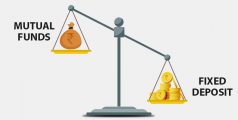
The Impact of Interest Rate Changes on Fixed Deposit Returns
Posted on Tuesday, May 9th, 2023 | By IndusInd Bank
Changes in interest rates can significantly affect the returns on fixed deposits, and investors must consider the impact of interest rates while making investment decisions. It’s important to use FD calculators to understand the impact of interest rate changes and to time investments and diversify portfolios to maximise returns. IndusInd Bank provides attractive interest rates and comes with several benefits for everyone.
Are you considering investing your money in a fixed deposit account to get higher returns? If so, you must consider the potential impact of interest rate fluctuations on your return. Interest rates can be volatile and highly unpredictable; what goes up today may go down tomorrow. Understanding the connection between varying interest rates and the returns provided by fixed deposits is essential. In this article, we’ll explore how changes in interest rate levels could affect the returns earned from fixed deposits so that you can make an informed decision and decide whether it’s right for you.
How Interest Rates Affect Fixed Deposits?
Fixed deposits are among the most popular investment options because of their guaranteed returns. However, the interest rates offered on fixed deposits are not static and are subject to change over time. Interest rate changes can significantly impact the returns of your fixed deposits. When the interest rates increase, the returns on fixed deposits also increase, and vice versa. This is because the interest rate is the most crucial factor determining the interest earned on a fixed deposit. Therefore, it is essential to understand how interest rates affect fixed deposits and their returns.
Factors That Influence Interest Rates
- Economic conditions: Interest rates are primarily influenced by the state of the economy. When the economy is doing well, the demand for credit increases, and so do interest rates. Conversely, when the economy struggles, interest rates tend to fall to stimulate borrowing and spending.
- Inflation: Inflation has a significant impact on interest rates. If inflation is high, lenders must charge higher interest rates to compensate for the decreased purchasing power of the money they lend.
- Central Bank Policy: Central banks are crucial in influencing interest rates. They can raise or lower interest rates to control inflation and promote economic growth.
- Repo rate: When the repo rate decreases, banks may lower their fixed deposit interest rates to encourage lending and stimulate economic growth. Similarly, when the repo rate increases, banks may raise their fixed deposit interest rates to attract more deposits and meet their lending needs.
- Government policies: Government policies, such as tax cuts or increased spending, can also impact interest rates. For instance, if the government increases its spending, it can cause interest rates to rise due to increased demand for credit.
- Global economic conditions: Interest rates in one country can also be influenced by global economic conditions. For example, a global recession can cause interest rates to fall in many countries, regardless of their economic conditions.
Impact of Interest Rates Changes on Fixed Deposit Returns
- Higher interest rates lead to higher returns: When interest rates increase, fixed deposit returns also increase, making them a more attractive investment. Conversely, when interest rates decrease, fixed deposit returns decrease as well.
- Longer tenures are affected more: Fixed deposits with longer tenures are more affected by changes in interest rates than those with shorter tenures. This is because the longer the tenure, the more time the deposit is exposed to changes in interest rates.
- Opportunity cost of locking in funds: When interest rates rise, fixed deposits become more attractive but may also come with a cost. Fixed deposits typically require you to lock in your funds for a specific period, so if interest rates continue to rise, you may miss out on other investment opportunities.
- Inflation can erode returns: High inflation can significantly reduce the real returns on fixed deposits. If inflation rates exceed the fixed deposit interest rate, the real value of the investment decreases over time.
- Interest rate fluctuations can impact reinvestment: If you plan to reinvest your fixed deposit at maturity, interest rate fluctuations can impact the returns on your reinvestment. If interest rates have decreased, reinvesting at the lower rate may result in lower returns.
The impact of changes in interest rates on fixed deposit returns is evident, affecting both depositors and investors. With an understanding of the effect of changing interest rates, you can make suitable decisions according to your financial goals.
Disclaimer: The information provided in this article is generic in nature and for informational purposes only. It is not a substitute for specific advice in your own circumstances. Hence, you are advised to consult your financial advisor before making any financial decision. IndusInd Bank Limited (IBL) does not influence the views of the author in any way. IBL and the author shall not be responsible for any direct/indirect loss or liability incurred by the reader for taking any financial decisions based on the contents and information.



 Offers
Offers Rates
Rates Debit Card Related
Debit Card Related Credit Card Related
Credit Card Related Manage Mandate(s)
Manage Mandate(s) Get Mini Statement
Get Mini Statement
 categories
categories Bloggers
Bloggers Blog collection
Blog collection Press Release
Press Release


